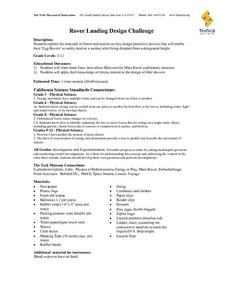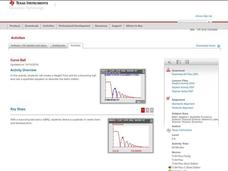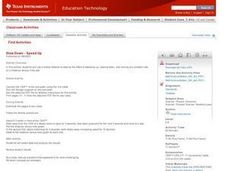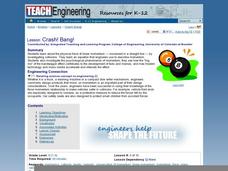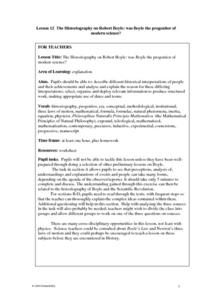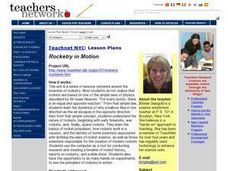Curated OER
FORCES, MOTION, AND ENERGY
Eighth graders engage in a variety of activities in order to investigate the basic concepts of physics. They read and answer questions in a written text. This is only one type of activity that is part of many others.
Curated OER
How Do Probes Get To Space
Students investigate how force works to propel rockets into outer space. In this physics lesson, students use a drinking straw, fishing line, a balloon, and tape to explore how force works in outer space. Students repeat the experiment...
Curated OER
F = a, Inertia, and Friction
Fourth graders use a matchbox car to push across a hard surface and observe what happens. They then push the car across a soft or rough surface and discover what happens. The two ideas are discusses as Newton's First and Second Laws of...
Curated OER
Rover Landing Design Challenge
Learners examine the concepts of forces and motion. They work together to design protective devices for their egg rovers as they are dropped from a specific height. They record their observations and discuss.
Curated OER
F = Ma, Inertia, And Action-reaction
Fourth graders investigate Newton's Second and Third Laws of Motion. They determine what makes objects harder or easier to push. While investigating they determine how applying force in order balance out gravity allows things to stay...
Curated OER
Curve Ball
Learners explore the concept of parabolas by collecting quadratic data on a bouncing ball as it is falling using a motion detector. They plot the data and determine the equation of the quadratic in vertex form, then determine the values...
Curated OER
Slow Down - Speed Up
Pupils explore the concept of distance and time as they use a CBR to mimic distance v. time graphs. Learners walk towards and away from the monitor to create various distance v. time graphs, then discuss what motion creates certain graphs.
Curated OER
Falling Objects
High schoolers examine the velocities of two different falling objects. They produce distance vs. time and velocity vs. time graphs using a Motion Detector and a CBL 2 to collect experimental data. Learners analyze and interpret the...
It's About Time
Run and Jump
Has your class wondered how fast a human could run or how high they are capable of jumping? Help them understand these concepts as they explore acceleration and use an accelerometer to make semiquantitative measurements of acceleration...
It's About Time
Automatic Triggering Devices
How does the air bag trigger in an accident? The lesson explores how automatic triggering devices work in automobiles. Using examples such as a seat belt lock and air bag, scholars design their own device to better understand the...
Curated OER
Where Will It Go?
Students predict the path of a ball bouncing off an object. In this physics activity, students conduct the rolling ball experiment to test their prediction. They perform several trials for accuracy.
Curated OER
Balloon Rockets
Students, after reviewing and analyzing Newton's third law of motion, make balloon rockets and experiment with a variety of models. After the experiment, they chart the results and form conclusions. In addition, they compare/contrast...
Curated OER
Rocket Science 101
Students explore the aspects of Newton's First and Third Laws of Motion as they conduct controlled rocketry experiments and analyze the Mars Mission in terms of the principles of rocketry.
Curated OER
Vectors
Students describe motion by the use of adding vectors to obtain the resultant vector. They comprehend the meaning of a resultant vector. Students identify the difference between the x and y components of vector quantities. Students...
Curated OER
Scientist/ Webelos Activity Book
In this physical science worksheet, students write short responses for each scientific law in 14 different questions to obtain a merit badge.
Curated OER
Crash! Bang!
Young scholars study the physical force of linear momentum by investigating collisions. They analyze the difference between elastic and inelastic collisions. They calculate linear momentum.
Curated OER
The Historiography on Robert Boyle: Was Boyle the Progenitor of Modern Science?
High schoolers participate in a warm-up activity by attending a football match writing an account of who won the game. They discuss how their account could differ from someone else's account of the game. They discuss how different...
Curated OER
Merging Art and Science?
Students approach science through artwork. In this art and science instructional activity students work together to develop theories and gather data.
Curated OER
States of Matter Mini-Unit
Students identify he phases of matter (solid, liquid, gas), and why they take place. They comprehend what a physical change is and what a chemical change is. Students know the difference between a Mixture and a Solution.
Curated OER
Rocket Me into Space
Fourth graders study the concept of thrust and how it propels rockets into space. They discover why airplanes cannot travel into space while considering the engineering techniques use in designing rockets. They look at how space...
Curated OER
Weight and Velocity
Students perform an experiment in order to determine how increasing weight affects the velocity of a truck and use the computer to compile their data.
Curated OER
WHAT HOLDS US TO EARTH?
Middle schoolers they imagine they are Galileo and try to duplicate Galileo's experiments and results.
Curated OER
Rocketry in Motion
Students investigate why a balloon flies in one direction as air escapes in the opposite direction, which helps them understand the nature of rockets and fireworks. Individually and in teams, students conduct research to create a...
Curated OER
Balloonautics
Young scholars are introduced to basic aerodynamics through a discussion of thrust and drag and a hands-on activity. They examine the forces of thrust, drag, air pressure, aerodynamic shapes and Newton's Third Law Of Motion.





